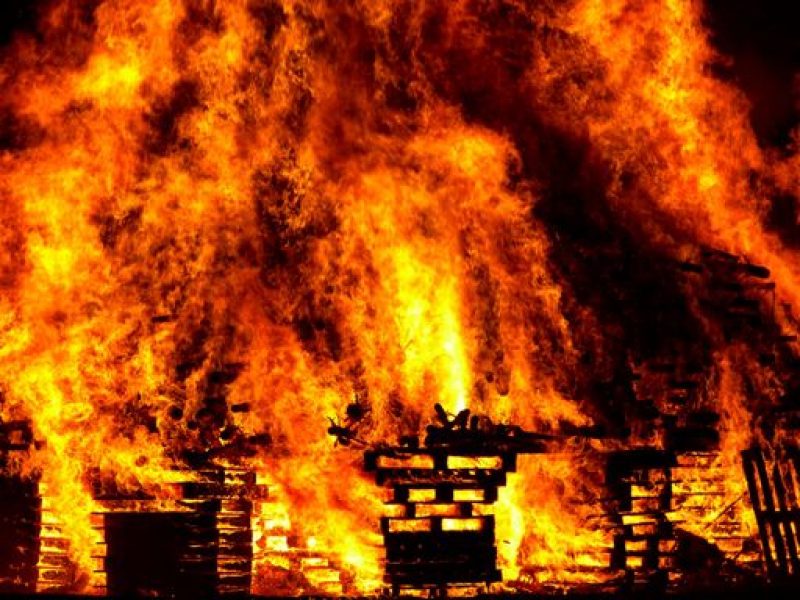
Blogs •
November 25, 2020
Prep and Plan for Fire Evacuation & Other Emergencies
Fire Dangers
According to the National Fire Protection Association, home fires caused by electrical failure or malfunction occur an average of 44,880 per year. Disastrous fires cause the deaths of about 440 individuals and injure another 1,250, which is why it’s crucial for families to develop a fire and evacuation plan before these emergencies occur. Property damages total $1.3 billion annually.
Fifty percent of electrical home fires occur because of distribution of electricity, lighting and power transfer equipment. Another 15% are caused by cooking equipment; 9% are the result of heating equipment; 6% due to fans; and 3% each from air conditioners and clothing dryers.
A cold 3-month period – from November through February – account for 40% of all electrical fires and the majority of deaths. Fires caused by electrical malfunction or lighting often originate in a bedroom.
When developing a fire and evacuation plan for home, it’s important to know where they are generated. Home electrical fires can start in wiring, electrical distribution systems, and lighting equipment, as well as in any equipment powered by electricity associated with:
• Cooking
• Heating
• Office
• Entertainment
• Washers and dryers
• Lighting
Fire and Evacuation Plan for Home
House fires include the unexpected, sometimes fatal blazes that cause both personal physical damage and emotional harm. It’s a life-changing event, one that is neither invited nor easily avoided, so following a guide to evacuating is helpful for maximum success.
According to an article by Travelers Insurance, there are more than 300,000 house fires annually and by taking some steps, you can gain an advantage in fighting its negative effects.
Consider every resident in the house: Whether you have elderly parents living with you or young children at home, there are special needs that need extra consideration in your fire evacuation plan. What kind of mobility do they have? Will you have to carry them out in the case of fire?
Even in homes with fire alarms, not everyone is capable of hearing them sound off. You may have to put in place a system with added checks on these individuals, which adds to the time you take to escape fire.
Find more than one exit: If the fire occurs between you and the only exit door, it’s obviously inescapable. A fire evacuation plan should determine in advance which way you can crawl, jump or otherwise get away. Make sure these additional doors and windows are easy enough to open, because you won’t get a warning in advance.
Get children involved in writing your fire and evacuation plan:  Your kids are more committed to the plan when they’re a part of it. Also, they sometimes have ideas that escape adults because of their size and ability to imagine. Draw maps so they have a visual indicator – it’s easier for them to follow your evacuation plan that way.
Your kids are more committed to the plan when they’re a part of it. Also, they sometimes have ideas that escape adults because of their size and ability to imagine. Draw maps so they have a visual indicator – it’s easier for them to follow your evacuation plan that way.
Designate a meeting location: You may choose your sister’s, your neighbor’s home, a park or even a stop sign – but pick somewhere that your family members can run to safety. By picking somewhere in the front of your house, emergency responders will see you and know that you’re accounted for.
It’s also important in learning how to evacuate that you understand you cannot return to the house after running to safety. Let the firefighters and law enforcement members do their jobs.
Make sure smoke detectors are in working condition: Change the batteries twice a year (some people choose to do that each time you set your clocks forward or back). Make sure they work properly, because they may very well save your lives. Put a smoke detector in each bedroom and on each level of your house.
Make your address visible: If your street number is easy to see, emergency personnel can find your house quickly once it’s called in.
Respond ASAP: Make a pact with your family that when the alarm sounds for a fire evacuation, you run outside like crazy.
Design a Plan B: In case things don’t go as expected, it’s a wise idea to have an alternative written into your fire evacuation plan. For instance, if the exit routes are on fire, you can put a towel at the bottom of the door and look for a window leading outside.
Make sure everyone’s on board: Share the procedure and practice it before an emergency occurs. It will feel like second nature, so you’re more likely to follow it successfully.
Guide to Evacuating – Professional Tips
The fire department of Arlington, Virginia has a post with lists of procedures and specifics your evacuation plans need to include.
A fire evacuation plan for your business needs to cover all the bases, including routes of escape for employees, as well as assignments of those who have to remain in place to finalize operations of equipment prior to evacuating.
Like a home emergency procedure, a company has to consider a form of evacuation for individuals who need assistance. There also has to be a system in your evacuation plan to account for the presence of individuals brought to safety.
When considering steps for how to evacuate, you need to outline where rescue services and medical aid can be obtained as well.
You also need procedures for notifying occupants when there’s an emergency such as a fire and a preferred and alternative means of notifying first responders of the emergency.
Your stated plan for how to evacuate also needs to assign personnel who can be contacted for further information.
If you’re the building owner, manager or corporate executive, you must make floor plans available which identify exits, primary evacuation routes, secondary evacuation routes, accessible egress routes, areas of refuge, exterior areas for assisted rescue, manual fire alarm boxes, portable fire extinguishers, occupant-use hose stations, fire alarm annunciators and controls.
What to Pack When You Evacuate
Because emergencies strike when you aren’t expecting them, you need a bag packed and ready to go. There’s always the chance you won’t be home or you won’t have time to bring what you’ve planned in advance, so your fire and evacuation plan should be in place so you’re ready for those situations when they occur.
 You can keep a fire evacuation emergency bag in your vehicle permanently. It should be equipped with extra snacks, clothing, shoes, a first aid kit, an external ecteronic charger, blankets, as well as a copy of your passport, driver’s license and proof of address, such as a bill, along with cash.
You can keep a fire evacuation emergency bag in your vehicle permanently. It should be equipped with extra snacks, clothing, shoes, a first aid kit, an external ecteronic charger, blankets, as well as a copy of your passport, driver’s license and proof of address, such as a bill, along with cash.
When you have advanced notice, for instance in the case of wildfires, preparing for an evacuation may include packing as many items as you can fit in your car. Experts advise only packing what you can’t replace. There are many documents and items that fall into this category, including:
• Photos and videos
• Gems and jewelry
• Heirlooms
• Computer drives
Some items may be replaceable, but it will make your life easier if you bring them with you. Medications, keys and hygiene supplies fall under this category. Many times, donations to victims of disasters go to replacing these types of supplies.
Among what to pack when you evacuate, include important documents. If you don’t have copies in your car already, be sure to have in your possession: social security cards, birth and marriage certificates, deeds to properties, leases, wills and financial records from insurance to legal paperwork.
The safety of your pets is important also. Keep them closed off in a room inside the house while you pack your vehicle. You don’t want to lose precious time chasing Fido down the road during an emergency.
Communication is a major concern when there’s a fire, earthquake or any disaster where victims and emergency personnel need to make contact. You can be “ever ready” by keeping battery-operated walkie talkies in your vehicles.
Be aware that although you are leaving in a hurry, when following through with your evacuation plan, it’s a good idea to offer added protection to your home by locking the doors, closing windows and shutting blinds.
Evaluating Evacuation Plan Progress
The U.S. Fire Administration has a how-to guide to enable your community to conduct a risk analysis and gauge whether or not you’ve devised a successful fire plan to reduce negative outcomes.
If you’re on your city council or in some form of leadership, you have a direct influence on the process of both prevention and developing a guide to evacuating. But even your neighborhood can put some efforts in place to lower the personal and financial costs in enduring disasters.
Develop a baseline by evaluating your current status when it comes to preparation for an emergency such as house fires. Once you’ve plotted this data, you can see if the changes you’ve instituted have an effect on the statistical results from disasters.
There are a lot of moving parts to the process of developing procedures for preventing and following a fire and evacuation plan and tracking progress. Determine your baseline through the following means:
• Conduct a risk analysis
• Devise a problem statement
• Develop a community risk profile
• Choose issues to take priority
• Target certain areas
After implementing some new tactics in the community, you can evaluate your success and develop strategies and timetables for fire evacuation. It may involve forming community planning teams, instituting interventions and modifying previous plans of action. You’ll have to market your intervention programs and expect to revise them as needed.
You don’t have to live in California to feel threatened by such disasters as fire. Preparing for an evacuation is often the best that you can do, because no one can eliminate emergencies. There is so much in life that’s out of your control, but an evacuation plan will at least limit the damage when you fall victim to disasters.
Donating to Fire Victims and Fire Foundations
The California Fire Foundation is a non-profit organization providing emotional and financial support to families of firefighters who fall in the line of duty, at the same time supporting other victims of natural disasters.
Professional firefighters in the state of California formed the Foundation in 1987 to aid in the aftermath of devastation from fires and the suffering that results. From the losses experienced by California fire victims to the sacrifice made by families of firefighters, there are unmet needs on every side of the equation.
Those with resources can become a part of the healing process through nonprofit agencies such as the California Fire Foundation.
